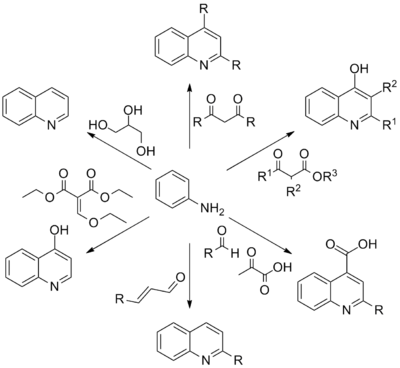
quinoline [kwin-l-een, -in] ExamplesWord Origin noun Chemistry.
- a colorless, liquid, water-immiscible, nitrogenous base, C9H7N, having a disagreeable odor, occurring in coal tar, and usually prepared by oxidizing a mixture of glycerol and aniline: used as a solvent and reagent and to make dyes.
Origin of quinoline First recorded in 1835–45; quin(ine) + -ol1 + -ine2 Also called leucoline. Examples from the Web for quinoline Historical Examples of quinoline
The antipyretic medicines which we have first to consider are derivatives of quinoline.
Raphael Meldola
When cinchonine is distilled with solid potassium hydrate, it yields pyrrol and bases of both the pyridine and quinoline series.
Scientific American Supplement, No. 415, December 15, 1883
Various
(d) The dye is thioflavine S., quinoline yellow, or one of their allies.
Robert Walter Sindall
This is not exactly the case with the higher groups of alkaloids—the derivatives of pyridine and quinoline.
Scientific American Supplement, No. 623, December 10, 1887
Various
Most of these are of a basic character, and belong to the pyridine and the quinoline series.
Encyclopaedia Britannica, 11th Edition, Volume 6, Slice 5
Various
British Dictionary definitions for quinoline quinoline noun
- an oily colourless insoluble basic heterocyclic compound synthesized by heating aniline, nitrobenzene, glycerol, and sulphuric acid: used as a food preservative and in the manufacture of dyes and antiseptics. Formula: C 9 H 7 N
- any substituted derivative of quinoline
quinoline in Medicine quinoline [kwĭn′ə-lēn′, -lĭn] n.
- An aromatic organic base synthesized or obtained from coal tar and used as a food preservative and in making antiseptics.
quinoline in Science quinoline [kwĭn′ə-lēn′, -lĭn]
- An aromatic organic liquid having a pungent, tarlike odor. Quinoline is a base and is obtained from coal tar or is synthesized. It is used as a food preservative and in making antiseptics and dyes. Chemical formula: C9H7N.
 Liberal Dictionary English Dictionary
Liberal Dictionary English Dictionary